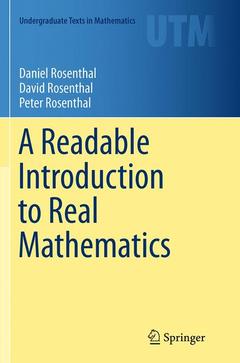Description
A Readable Introduction to Real Mathematics, Softcover reprint of the original 1st ed. 2014
Undergraduate Texts in Mathematics Series
Language: English
Subject for A Readable Introduction to Real Mathematics:
A Readable Introduction to Real Mathematics
Publication date: 09-2016
Support: Print on demand
Out of Print
Publication date: 09-2016
Support: Print on demand
Out of Print
A Readable Introduction to Real Mathematics
Publication date: 07-2014
161 p. · 15.5x23.5 cm · Hardback
Replaced by new edition: Access to the new edition.
Publication date: 07-2014
161 p. · 15.5x23.5 cm · Hardback
Replaced by new edition: Access to the new edition.
Description
/li>Contents
/li>Biography
/li>Comment
/li>
Designed for an undergraduate course or for independent study, this text presents sophisticated mathematical ideas in an elementary and friendly fashion. The fundamental purpose of this book is to engage the reader and to teach a real understanding of mathematical thinking while conveying the beauty and elegance of mathematics. The text focuses on teaching the understanding of mathematical proofs. The material covered has applications both to mathematics and to other subjects. The book contains a large number of exercises of varying difficulty, designed to help reinforce basic concepts and to motivate and challenge the reader. The sole prerequisite for understanding the text is basic high school algebra, some trigonometry is needed for Chapters 9 and 12. Topics covered include: mathematical induction - modular arithmetic - the fundamental theorem of arithmetic - Fermat's little theorem - RSA encryption - the Euclidean algorithm -rational and irrational numbers - complex numbers - cardinality - Euclidean plane geometry - constructability (including a proof that an angle of 60 degrees cannot be trisected with a straightedge and compass). This textbook is suitable for a wide variety of courses and for a broad range of students in the fields of education, liberal arts, physical sciences and mathematics. Students at the senior high school level who like mathematics will also be able to further their understanding of mathematical thinking by reading this book.
1. Introduction to the Natural Numbers.- 2. Mathematical Induction.- 3. Modular Arithmetic.- 4. The Fundamental Theorem of Arithmetic.- 5. Fermat's Theorem and Wilson's Theorem.- 6. Sending and Receiving Coded Messages.- 7. The Euclidean Algorithm and Applications.- 8. Rational Numbers and Irrational Numbers.- 9. The Complex Numbers.- 10. Sizes of Infinite Sets.- 11. Fundamentals of Euclidean Plane Geometry.- 12. Constructability.
Daniel Rosenthal is a mathematics student at the University of Toronto. David Rosenthal is Associate Professor of Mathematics at St. John's University in New York City. Peter Rosenthal is Professor Emeritus of Mathematics at the University of Toronto.
Presents sophisticated ideas in analysis and geometry in an elementary fashion
Includes exercises of varying difficulty to help motivate the reader
Features techniques to solve proofs that will be useful for future mathematics teachers and math majors
© 2024 LAVOISIER S.A.S.




